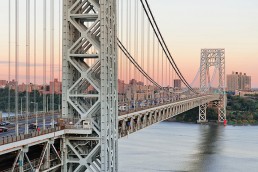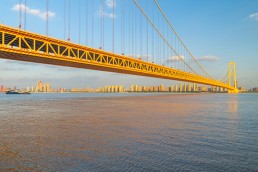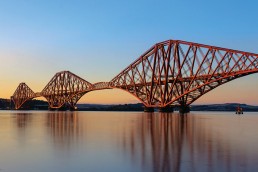Severn Bridge 1966
Severn Bridge 1966
© Craig Joiner
The Bridge
Dr William (Bill) Brown was the principal designer working with Sir Gilbert Roberts and the Freeman Fox & Partners team on the Severn Bridge. He is credited with designing the innovative aerodynamic box girder deck, which superseded the complex trusses used on earlier major suspension bridges in the UK (Forth Road Bridge) and the USA.
Bridges all over the world are descended from the design and engineering of the Severn Bridge.
Bill Brown's Aerofoil Hollow-box Deck
Cross-section of the Severn Bridge deck.
Severn Bridge
Linking England and Wales
Key Facts
Four-lane motorway bridge
First major bridge with a box-girder deck
A new chapter in bridge design
Location
England-Wales
Across the River Severn
Between Aust (England) and Beachley (Wales)
Designers / Engineers
Dr William (Bill) Brown
Sir Gilbert Roberts
Freeman Fox & Partners
Mott, Hay and Anderson
Description
Suspension bridge with diagonal hangers
987.5m main span
1,839m total length
Main contractors
Cleveland Bridge & Engineering Co. Ltd.
Dorman, Long and Co. Ltd.
John Howard and Co. Ltd.
Construction
Began 1961
Opened 8 September 1966
The Bridge Construction
There was pressure to minimise cost and use less steel on the Severn Bridge. Bill’s studies showed that a shallow welded box construction would have good torsional stiffness and be lighter and easier to build. An earlier truss deck design was accidentally destroyed during wind-tunnel testing and Brown and Roberts had the opportunity to test the new deck. It was found to have good aerodynamic performance that deflected the force of the winds.
The roadway deck was constructed from 88 box sections, each 40 metres long. They were assembled on the riverbanks of the adjoining River Wye, floated into position and hoisted to road level. The Severn Bridge replaced the Aust ferry, which had carried up to 19 cars at a time over the river. The long queues for the ferry that used to stretch two or three miles were now a thing of the past.
In 1966, it became an essential part of the new M4 motorway, reduced travelling time between London-Bristol-Cardiff and helped the economic development of South Wales. The Severn Bridge proved very popular, and soon up to 20,000 vehicles a day were crossing it. A new second Severn Crossing was constructed in the 1990s.
"It is a great artefact, a magnificent outline against the sky, which is a thing of sweeping grace, of light and seemingly effortless power."
William Dreghorn, author, Geology and the Severn Bridge









































































